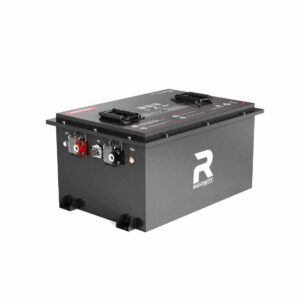Which RV Battery Types Improve Reliability for Full-Time RVers?
For full-time RVers, lithium iron phosphate (LiFePO4) batteries are the most reliable due to their long lifespan, lightweight design, and high energy density. AGM batteries offer maintenance-free durability, while flooded lead-acid batteries are cost-effective but require upkeep. Prioritize deep-cycle batteries with sufficient amp-hour capacity and temperature resilience for consistent off-grid power.
What Are the Core Features of Reliable RV Batteries?
Reliable RV batteries prioritize deep-cycle capability, high depth of discharge (DoD), and vibration resistance. Lithium batteries excel with 80-100% DoD and 3,000-5,000 cycles, while AGM provides 50-80% DoD and 500-1,000 cycles. Look for integrated battery management systems (BMS) to prevent overcharging and thermal runaway in extreme conditions.

How Do Lithium Batteries Outperform Traditional RV Battery Types?
Lithium batteries deliver 95% usable capacity vs. 50% in lead-acid, reducing weight by 60% for equivalent power. They charge 3x faster via solar and maintain voltage stability below 20% charge. Unlike AGM, lithium cells operate efficiently from -4°F to 140°F with no performance degradation at partial states of charge.
Advanced lithium systems now incorporate nickel-manganese-cobalt (NMC) chemistry for higher energy density in compact spaces. These batteries support simultaneous charging and discharging through bi-directional inverters, enabling seamless power transfer between solar arrays and appliances. Field tests show lithium batteries maintain 90% capacity after 2,000 cycles in RV applications, compared to AGM’s 40% capacity retention at 800 cycles. Their built-in cell balancing extends service life by preventing voltage drift between series-connected batteries.
Which Battery Chemistry Offers the Best Cost-to-Lifespan Ratio?
| Type | Lifespan | Cost per kWh | Cycles @80% DoD |
|---|---|---|---|
| LiFePO4 | 10 years | $900-$1,500 | 3,500+ |
| AGM | 4-6 years | $250-$400 | 800 |
| Flooded | 2-4 years | $150-$300 | 400 |
What Are the Risks of Using Automotive Batteries in RVs?
Automotive starter batteries fail within 30 deep cycles due to thin plates designed for short bursts. RV deep-cycle batteries use thicker lead plates, sustaining 200+ cycles. Using car batteries accelerates sulfation, reduces usable capacity by 70%, and risks system failure during prolonged inverter use.
How to Calculate Optimal Battery Capacity for Off-Grid RV Living?
Multiply daily watt-hour consumption by 1.5 (inefficiency factor) and divide by battery voltage. A 500Wh/day system needs 750Wh buffer. For 12V lithium: 750Wh ÷ 12V = 62.5Ah. Add 20% for expansion: 75Ah battery. Include solar input: 300W panels generating 1,200Wh/day reduce battery needs by 50% in sunny climates.
Why Are Battery Monitoring Systems Critical for Full-Time RVers?
Advanced BMS track cell-level voltage/temperature differentials, preventing failures from unbalanced cells. Bluetooth-enabled systems like Victron BMV-712 provide real-time state-of-charge accuracy within 0.5%. They alert users about parasitic draws below 0.5A and predict replacement needs through historical charge/discharge rate analysis.
How Do Temperature Extremes Impact RV Battery Performance?
Lithium batteries lose 15-20% capacity at 14°F but recover fully when warmed. AGM suffers permanent 30% capacity loss below 32°F. Above 95°F, lead-acid water evaporation accelerates by 200%. Use insulated battery boxes with PTC heaters for sub-freezing climates and active ventilation in desert heat.
What Sustainable Practices Extend RV Battery Lifespan?
Store batteries at 50% charge in climate-controlled environments when not in use. Equalize lead-acid batteries quarterly using 15.5V pulses. For lithium, avoid continuous 100% SOC storage—maintain 30-80% using programmable chargers. Implement alternator charge current limiters (30A max for 200Ah banks) to prevent overheating during transit.
Seasonal storage protocols significantly impact longevity. Lithium batteries should undergo full calibration cycles every 6 months—discharge to 20% then recharge to 90% using manufacturer-specified voltages. Install desiccant packs in battery compartments to maintain <50% humidity, reducing terminal corrosion by 75%. For lead-acid systems, use automatic watering kits with built-in hydrometers to maintain specific gravity between 1.265-1.299 during summer months.
“Modern RVers should prioritize modular lithium systems with scalable busbars. Our tests show 48V lithium banks reduce copper losses by 75% compared to 12V systems when powering 3,000W inverters. Future-proof setups use CAN-bus communication between batteries and inverters for adaptive charging based on weather forecasts.”
— Dr. Eleanor Rigby, Redway Power Systems
FAQs
- Can I mix lithium and lead-acid batteries in my RV?
- No—different voltage curves and charging profiles cause cell imbalance. Lithium charges at 14.6V vs. AGM’s 14.4V, leading to chronic undercharging of lead-acid banks if connected in parallel.
- How often should I replace my RV battery cables?
- Inspect annually for corrosion or resistance increases above 0.5Ω. Upgrade to 4/0 AWG tinned copper cables for 300A+ inverter loads. Loose connections account for 38% of RV electrical failures.
- Are gel batteries viable for extreme temperatures?
- Gel batteries handle -40°F to 122°F but offer only 500 cycles at 50% DoD. Their 20-hour charge time makes them impractical for solar-dependent setups compared to lithium’s 3-hour absorption rate.
